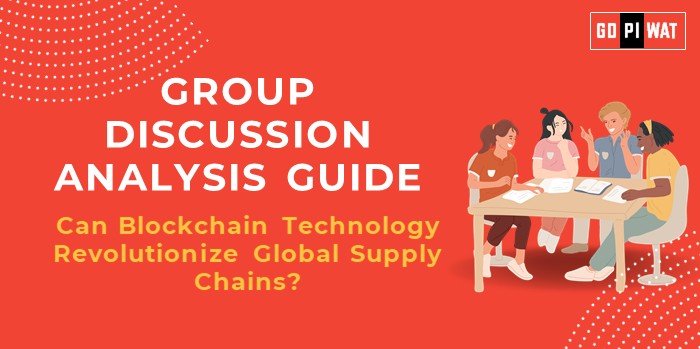📋 Group Discussion (GD) Analysis Guide: Can Blockchain Technology Revolutionize Global Supply Chains?
🌐 Introduction to Blockchain in Supply Chains
- Opening Context: Blockchain technology, often synonymous with cryptocurrencies, is rapidly expanding its applications, especially in global supply chains, promising increased transparency, traceability, and efficiency.
- Topic Background: Originating as a backbone of Bitcoin in 2008, blockchain offers decentralized, immutable ledgers. It is increasingly explored in supply chain management to resolve issues like counterfeiting, inefficiency, and fraud.
📊 Quick Facts and Key Statistics
- 💰 Counterfeit Goods Loss: $500 billion annually in global trade; blockchain ensures authenticity.
- 🍎 Food Safety: Walmart reduced food tracing times from 7 days to 2.2 seconds using IBM’s blockchain technology.
- 📈 Adoption Rate: 81% of executives in logistics expect blockchain to be a key technology by 2025.
- 💸 Cost Savings: Blockchain can reduce supply chain operating costs by up to 20%.
👥 Stakeholders and Their Roles
- 🏛️ Government Agencies: Regulate blockchain standards and encourage adoption (e.g., FDA in food supply chains).
- 🏢 Corporations: Implement blockchain for enhanced traceability and efficiency.
- 🙋♀️ Consumers: Benefit from transparency in sourcing and authenticity.
- 💻 Technology Providers: Develop blockchain platforms tailored for supply chains (e.g., IBM, Hyperledger).
🏆 Achievements and Challenges
✨ Achievements
- Transparency: Firms like Maersk and IBM’s TradeLens provide real-time shipping data.
- Fraud Prevention: Blockchain eliminates counterfeits through tamper-proof records.
- Cost Reduction: Automating processes reduces manual errors and operational costs.
⚠️ Challenges
- Scalability: Current blockchains struggle to handle the volume of global trade.
- Regulatory Uncertainty: Lack of standardized laws hinders adoption.
- High Costs: Initial setup and integration remain barriers for small businesses.
🌍 Global Comparisons
Estonia leads in blockchain use for logistics, while developing nations struggle due to infrastructure issues.
📚 Structured Arguments for Discussion
- 💪 Supporting Stance: “Blockchain is revolutionizing supply chains by ensuring transparency and reducing fraud globally.”
- ❌ Opposing Stance: “Scalability and regulatory barriers prevent blockchain from being a universal solution.”
- ⚖️ Balanced Perspective: “Blockchain offers transformative potential but requires global collaboration and technological advancements to realize its full impact.”
💡 Effective Discussion Approaches
- 📊 Opening Approaches:
- Data Highlight: “Supply chain losses due to inefficiency exceed $1 trillion annually; blockchain is a game-changer.”
- Global Comparison: “Estonia’s blockchain adoption in logistics offers a benchmark for the world.”
- 🎯 Counter-Argument Handling:
- “While scalability is an issue, Layer-2 solutions like Polygon are emerging to address these bottlenecks.”
🔍 Strategic Analysis of Strengths and Weaknesses
- ✅ Strengths:
- Real-time tracking.
- Tamper-proof records.
- ❌ Weaknesses:
- High implementation costs.
- Energy-intensive operations.
- 🚀 Opportunities:
- Integration with IoT for smart supply chains.
- Expansion in food safety sectors.
- ⚠️ Threats:
- Cybersecurity risks.
- Resistance from traditional supply chain operators.
🎓 Connecting with B-School Applications
- 📌 Real-World Applications: Projects on blockchain integration in logistics or case studies like TradeLens.
- ❓ Sample Interview Questions:
- “How can blockchain improve sustainability in supply chains?”
- “Discuss the role of blockchain in addressing counterfeiting.”
- 📘 Insights for B-School Students:
- Explore startups innovating in blockchain.
- Investigate the role of public-private partnerships in driving adoption.


